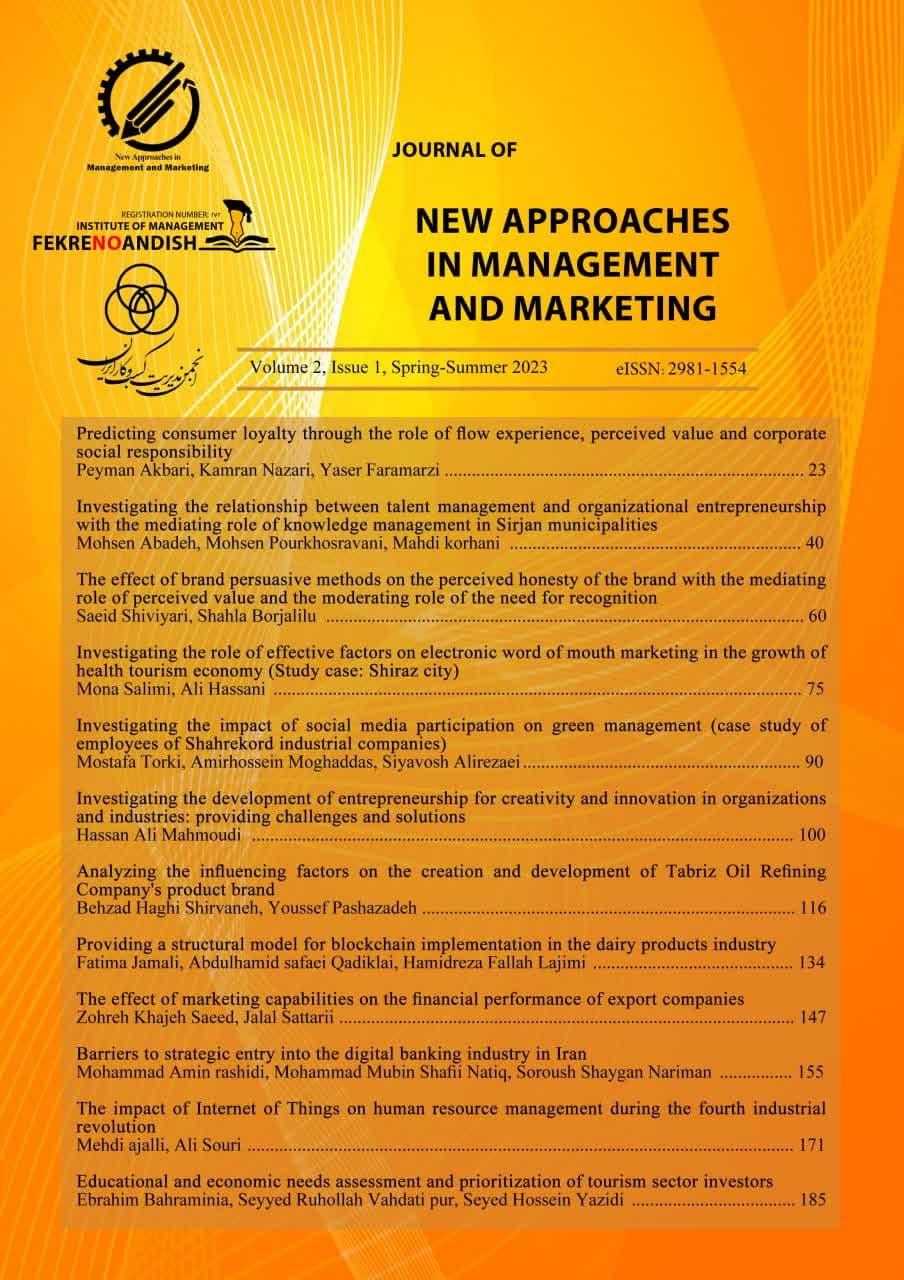Asadpour Golugahi, Razi and Seyed Mehrdad Moghadam Ziabri, (2017), the relationship between honesty and emotionality dimension of brand personality with consumer loyalty, International Conference on New Research Achievements in Economic Accounting Management, Tehran, Nikan Institute of Higher Education. (In Persian) .
Buil, I.; Catalan,S & Martinez, E (2015). The importance of corporate brand identity in businesss management: an application to the UK banking sector, BRQ Business Research Quartrly, 19(1), 3-12.
Chiu, H., Hsieh, Y., and Kuo, Y. (2012). How to align your brand stories with your products. J. Retail. 88, 262–275. doi: 10.1016/j.jretai.2012.02.001.
Dupreez, R & Bendixen, M.T (2015). The impact of internal brand management on employee job satisfaction, brand commitment and intention to stay. International Journal of Bank Marketing, 33(1), 78-91.
Esfandiani, Seyyed Hamid. Karimian, Mojtaba. and Meshbaki, Asghar. (2021), The effect of consumer brand communication on the implementation of brand persuasion, Modern Marketing Research Quarterly, 5th year, 1st issue, pp. 169-182. (In Persian) .
Erturk,A (2010). Exploring predictors of organizational identification: Moderating role of trust on the association between empowerment, organizational support, and identification. European Journal of Work and organizational psychology, 19(4), 409-441.
Evans, C. J., Kirby, J. R., Fabrigar, L. R. (2018) Approaches to learning, need for cognition, and strategic flexibility among university students. British, Journal of Educational Psychology, 73, 507-528.
Fiol, L. J. C., Alcañiz, E. B., Tena, M. A. M., and García, J. S. (2009). Customer loyalty in clusters: perceived value and satisfaction as antecedents. J. Bus.Bus. Mark. 16, 276–316. doi: 10.1080/10517120802496878.
Hosseini Mirzahasan, Farhadi Nihad Romina (2018). Identifying the scales for measuring the mental image of the brand in the university. Educational measurement: Volume 3, Number 8, from page 109 to page 132. (In Persian) .
Huang, C, & Zhuang, S, & Ziyuan, J, (2022), Creating a Sincere Sustainable Brand: The Application of Aristotle’s Rhetorical Theory to Green Brand Storytelling, ORIGINAL RESEARCH, published: 02 June 2022, doi: 10.3389/fpsyg.2022.897281
Higgins, C., and Walker, R. (2012). Ethos, logos, pathos: strategies of persuasion in social/environmental reports. Account. Forum 36, 194–208. doi: 10.1016/j. accfor.2012.02.003.
Kazemi, Shahram and Armaghani, Javad (2020), "Effect of brand loyalty on bank brand equity from the point of view of electronic card customers", Industrial Management Quarterly, Faculty of Humanities, Islamic Azad University, Sanandaj Branch, 5th year, number 14, pp. 103-120. (In Persian) .
King, C, & Grace, D (2016). Exploring manager’s perspectives of the impact of brand management strategies on employee roles within a service firm. Journal of Services Marketing, 20(6), 369-380.
Konti F. (. 2019) Teachers and students perceptions towards teachers’ classroom management applications in primary schools. Procedia - Social and Behavioral Sciences, 15: 4093–4097.
Nikal, N & Mukherjee, A. (2019). the relative influence of organizational commitment and job satisfaction on service quality of customer contact employees in banking call centers. Journal of Service Marketing, 18(3), 162-174.
Rose, F. (2011). The art of immersion: how the digital generation is remaking hollywood, Madison Avenue, and the way we tell stories. Int. J. Advert. 30, 915–919.
Ryu, K., Lehto, X. Y., Gordon, S. E., and Fu, X. (2019). Effect of a brand story structure on narrative transportation and perceived brand image of luxury hotels. Tour. Manag. 71, 348–363.
Shirzadi, Puya and Farrokh Guchhani, (2018). Examining the effect of brand authenticity on brand trust, 5th National Conference and 3rd International Accounting and Management Conference, Tehran, Top Service Company. (In Persian) .
Soo-Vijande, María Leticia, del RíoLanza, Ana Belén, Suárez-Álvarez, Leticia, & Díaz-Martín, Ana María. (2013). The brand management system and service firm competitiveness. Journal of Business Research, 66(2). 148-157.
Sanders, J., and van Krieken, K. (2018). Exploring narrative structure and hero enactment in brand stories. Front. Psychol. 9:1645. doi: 10.3389/fpsyg.2018. 01645.
Yi Chan,., and Chang, Y. (2020). A web-based review titled Product Placement Processing and Brand Persuasiveness. J. Promot. Manage. 19, 674–686.
Zaree, Kamal. (2022), on investigating the role of persuasiveness and brand evangelism in creating experiential added value (case study: Asian insurance customers in Hamedan province), Management Research, No. 86, pp. 27-52. (In Persian).

